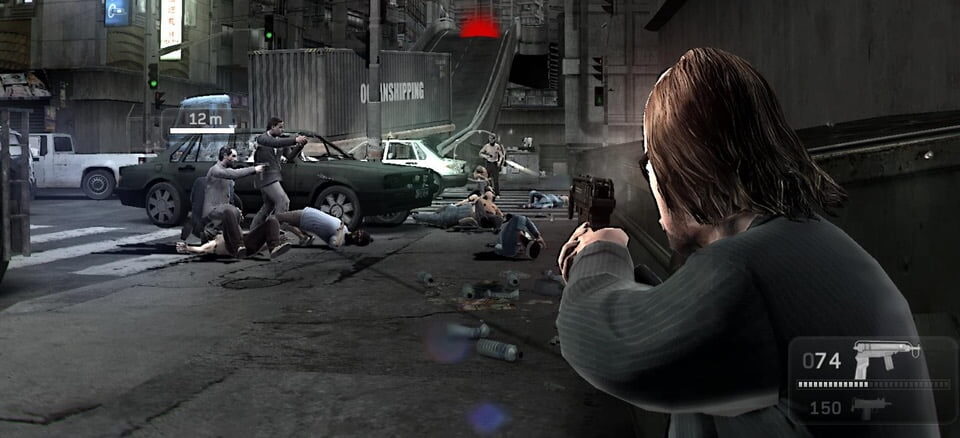A study of the characters and lyrical themes of Kane & Lynch 2: Dog Days.
In the first half of this essay I examined the aesthetic strategies of Kane & Lynch 2: Dog Days as expressing a documentarian style and commenting on our relation to images. I also analyzed the Shanghai setting and linked it to an exteriorization of the characters’ troubled psyches. I continue my survey on the game with a character study and a closer look at its themes
Kane & Lynch 2: Dog Days holds up with multiple replays since its initial release in 2010, and to this writer’s eyes, gains substantially in depth too. The steady reconsideration of initially shafted or overlooked games like Binary Domain, Haze, or Alpha Protocol given our slightly better critical outlook in comparison to a half-decade ago lends these works a fairer and smarter appraisal. Video games culture, particularly its mainstream critical coverage, suffers greatly from shortsightedness in writing that resists a broader artistic and political conversation in favor of soulless talk on systems over themes and meaning. Consequently, I deem it useful to reassess works that have fallen under the radar over the years, especially when they’re as visually striking and thematically weighty as Kane & Lynch 2. I hope to do the folks at IO Interactive some justice in lifting up a game that’s far better than what the general games culture will have you believe, and to recognize how such works themselves are constantly changing alongside a dynamic critical landscape.
KILLING THE HARMLESS
In part one of this essay, I closely examined how the game communicates its bleak tone through aesthetic strategies, and this notion also stretches over to gameplay and characterization. Kane & Lynch 2: Dog Days is a proper game about crime, centralizing wretched, heinous criminals well beyond hope for moral recovery. Forget Grand Theft Auto V; these are true, unrepentant criminals not meant to garner any appeal. Dog Days is fundamentally about violence administered by detestable figures in an unresponsive world cut off from the familiarities of a civil society. Like the Michael Mann films it draws from—Collateral and Miami Vice being the key texts here in contrast with Kane & Lynch: Dead Men’s Heat—this game is coldly presented and interested in rough, dreary themes of desperation, informal power structures, and the unhealthy inability of characters to express emotional vulnerability to move past grievances.
In expressing such ideas, Dog Days provides a raw awkwardness to its images that allows players to literally align themselves uncomfortably close to the game’s characters. Kane and Lynch are ugly, sweaty middle-aged men pricked with unseemly scars and resembling rabid swine in their bloated, greasy physiques. Inwardly and outwardly, these are unattractive, toxic men who end up doing nothing else but hurting other people. During shootouts on the city streets of Shanghai, you’ll aim in the direction of enemies raining down hell upon you, but you’ll also inevitably and indiscriminately shoot into innocent crowds because Kane and Lynch are no heroes. Perhaps even more vividly than Spec Ops: The Line, Kane & Lynch 2: Dog Days emphasizes violence enacted upon incidental, innocent bystanders to underline the inherently destructive capacities of its protagonists. While in cover behind standstill traffic, you can shoot through car windows to pick off enemies in the distance, all the while killing the passengers huddled inside. Kane and Lynch make no mention of securing pedestrians, nor does the game penalize the player for firing upon non-combatants.
In critic Brendan Keogh’s book Killing Is Harmless, he turns the conversation on shooter video games inwardly to interrogate the portrayal of video game violence through the lens of Spec Ops: The Line. That game outwardly frustrates the formula that shooter games have offered for years, and Keogh is interested in teasing out how it reflexively upends player enjoyment and genre expectations in order to question the medium’s depiction of violence. Critical conversation on Spec Ops has largely worn itself out, and so turning to less obvious works like Kane & Lynch 2 offers a larger canvas to further develop these arguments. As in Spec Ops: The Line, the unadorned, often clunky third-person shooter gunplay only heightens the tension and brute physicality of Dog Days to frustrate what we come to expect of shooter games. If Dog Days provided smooth and tight gameplay mechanics, it would only fail in its depiction of sloppy and chaotic shootouts and undermine the notion that Kane and Lynch are bad people. That the shooting in this game is imprecise and unpolished further communicates to the player the impulsive, devil-may-care attitudes of its characters and mirrors the repulsive milieu of the game.

Moreover, pressing the button to sprint causes the camera to wildly convulse as though the unseen camera operator is struggling to keep up with the characters, adding a sense of constructed realism and jumbled, vertiginous urgency. The sense of sustained, spontaneous chaos as Kane and Lynch descend deeper into an unholy, violent underworld demands that players experience Dog Days in higher difficulty settings in order to better mimic the hellish forward slog that these characters endure. You’ll trade gunfire across abandoned highways and in shadowy parking garages buried below the city, exchanging violence in frenzied hurry and with the slapdash nature of desperate men on the run.
In your weapons’ sights is a mix of dangerous, cryptic enemies everywhere from corrupt law enforcement donned in shatterproof raid gear and ghostly night vision goggles to run-and-gun kamikaze gunmen in nothing but grubby undershirts. Oftentimes, combatants will simply be faceless figures in balaclavas, firing cheap automatic weapons and crumpling under your return gunfire, through later in the game, more heavily clad and ruthless soldiers in military fatigues greatly slower your progression. The most visually cryptic enemies in Kane & Lynch 2: Dog Days appear as a firing squad across from Lynch’s apartment dressed in fully white painter suits with white masks, complete with eyes painted closed as though in relaxed nirvana. Their quick movements darting from cover to cover resemble ghostly apparitions tormenting the game’s protagonists, and when gunned down, their dead bodies with their closed-eyed masks in smiling tranquility cuts a chilling image. Indeed, Dog Days is often casually enigmatic, especially when such enemies seem to have no origin other than a cryptic void. They crawl out from up under the Shanghai underworld, anonymous and omnipresent with no motivation other than to kill. Similarly, the corrupt police force is portrayed as beyond moral comprehension, revealed to be tying up civilians in abandoned back rooms and leaving them for dead. In Kane & Lynch 2, violence is not only ubiquitous but even esoteric, prompting questions with no answer and evoking loaded images that linger in the mind long after the credits roll.
The basic gameplay and enemies aside, the central protagonists Kane and Lynch themselves raise plentiful topics of inquiry about unreliable narrators and the nature of criminality and evil in video game stories. Like the outlaws of Sam Peckinpah movies, these nocturnal gunslingers frustrate what we consider “heroes” in genre fiction, operating beyond the parameters of civil society and displaying manic, compromised psychological states. They’re less High Noon and more like The Wild Bunch, or less Die Hard and more of Bring Me the Head of Alfredo Garcia. That is to say, Kane and Lynch are following in the tradition of a certain kind of criminal protagonist—typically cinematic in origin—that upholds violence only to accelerate their own self-destruction. Kane and Lynch are men who think they can escape from their pasts, but they’re ultimately too narrow-minded to realize that they’ve embodied the very demons they wish to exorcise. Kane aspires to reconnect with his estranged daughter Jenny, a desire that either imposes a specific interpretation of the events of the previous game Dead Men or reinforces a very disturbing idea of what Kane’s headspace is like given the disastrous conclusion to his story arc from the first game.

Lynch on the other hand makes the naïve assumption that he can settle down in leisurely domestic bliss with his girlfriend Xiu, but violence inevitably is drawn back into the fore. The notion that either Kane or Lynch could settle down and lead normal lives apart from criminality seems entirely absurd. They think they can live and then shed a criminal lifestyle without repercussions, as though evil can be used in the service of yielding a fresh, good start when in reality evil just begets more evil. What Kane and Lynch forget is that morality is nonexistent in hell, and thus a paradox emerges: these characters have no life without violence and the constant threat of death, because otherwise, they’ll always be unfulfilled and trapped. Evil and violence is simply synonymous with their characters, what writer Max Chis identifies as linguistic in origin, where “even their names evoke deep-rooted evil.” More specifically, I imagine the implication is that Kane alludes to the biblical Cain in the Christian account of the origin of murder and Lynch alludes to either Lynch Law (capital punishment without trial) or filmmaker David Lynch and the dark and carnal surrealism of movies like Lost Highway or Blue Velvet. Hell, I’m even under the impression that the scowling gangster Glazer is a reference to director Jonathan Glazer, whose hedonistic gangster culture in Sexy Beast and the merciless, abstract alien void in Under the Skin seems analogous to the world of Kane & Lynch 2: Dog Days.
What the characters of Dog Days represent is true villainy with no possible means of virtuous redemption, and certainly not the formulaic antihero protagonists in constant vogue in the world of video games. Kane and Lynch are not characters that share the grizzled populist heroics of Aiden Pearce of Watch Dogs, whose hacktivist trench coat and face scarf feels tailor-made for merchandizing purposes, nor are they like the handsome, free-spirited rogue Edward Kenway in Assassin’s Creed IV: Black Flag. These antiheroes are designed with flaws in order to make them more humanly relatable and attractive because they have vulnerabilities that translate into underdog narratives. With Kane and Lynch, the writers have crafted wholly unlikable, unreliable narrators who indiscriminately fire into crowded city streets alongside cops who often kill civilians in their furious manhunt. In consequence, the two Kane & Lynch titles and especially Dog Days are games about violence and evil, where human conflict is juxtaposed against grander evils of capitalist exploitation and the perpetuation of toxic masculinity.
Kane & Lynch and Kane and Lynch are the embodiment of all these themes, upturning what we come to expect in action games and typical video game storytelling. The only language they seem to bark is “kill,” unable to operate outside the parameters of death and destruction. This is a notion that the phenomenal review for Action Button understands thoroughly, observing that the characters “kill about half of China on their way to hijacking a plane,” or in other words, “what they do is something the average player has done thousands of times before in different contexts: they kill.” What the review suggests is that Kane & Lynch 2: Dog Days represents a reflexive commentary on shooter games, calling into question not just itself but an entire lineage of seemingly innocuous but inherently violent video game characters like Nathan Drake of Uncharted or Rico Rodriguez of Just Cause. Instead of fun romps by charismatic, endlessly quipping rogue types, the Kane & Lynch games identify the familiar actions of video game protagonists as sociopathic.
Dog Days effectively articulates its protagonists’ sociopathic qualities, from the narcotized hysteria of Lynch and a brilliantly brash performance by Jarion Monroe to the more understated performance by Brian Bloom as his partner Kane. Monroe’s Lynch in particular carries an animalistic, savage drive throughout the game. Lynch growls with anger, often mumbling his thoughts aloud or just snarling and grunting to fill the dead air. The performance exudes Lynch’s solipsistic vehemence and a closed-off interior world. During shootouts, Lynch will occasionally talk to himself by way of delusional mantras that keep him afloat amidst the carnage around him, intoning, “This is easy… You’re the fucking man.” At other times, his scattered snatches of dialogue manifest with a more cryptic nature that bespeaks his paranoiac mentality. I remember one particularly expressive aside where Lynch speaks aloud, “It’s dark… can’t see anything” without a follow-up response. Lines like these often hover overhead, raising questions without response and further clouding an already unknowable world.
THROUGH A LENS DARKLY
A little over halfway through the game, Kane and Lynch will find themselves like a pair of lacerated hogs, the characters butchered, naked, and bleeding in a disgusting back room in Shanghai. The digital camcorder seen at the very start of the game receives its context here. They’re being tortured and left for dead like in a snuff film or an obscure gangland execution video uploaded to YouTube, and this entire sequence feels like a horror movie. A dark thunderstorm rages outside, the cold rain pelting down. Lynch awakens in a discombobulated and exposed state thrown away in a garbage dumpster, and his nude body is riddled with open cuts that bleed profusely. You control him as he gradually stalks forward into an unknown building with the slow prowl of a predator ready to kill. The only sound is Kane’s muffled screaming in the distance.
Such immediately and plainly presented violence calls to mind the snuff aesthetics of Manhunt and Hotline Miami 2: Wrong Number, games that are similarly engaged in themes of the representation of violence and the mediation of digital video aesthetics in reorienting us with these lurid images. Linking these three games together is the ubiquity of a cheap home video style that depicts obscene ultraviolence enacted by sadistic men. That these acts of violence in all three games are recorded suggests the voyeuristic pleasure of re-watching it from an emotional distance. Indeed, both Manhunt and Hotline Miami emphasize the act of spectatorship and contemplation through its images. The former steals away direct player agency when landing an execution by abruptly showing it in a quick cutscene rather than have the player perform it to its completion. The latter compels the player to gaze upon their enacted violence by requiring them to retrace their steps back through the level now littered with grotesque corpses sprawled in mangled positions or squashed entirely. These are moments that confront the player with images of violence and our implication in such depravity. Kane & Lynch 2: Dog Days radiates comparable ideas with the naked bodies and pixelated gore on display during this sequence, evoking gangland or cartel-style snuff horror of mutilated bodies and real-life worlds of unimaginable pain.
This midpoint sequence dips into the realm of survival horror imagery: two blood-soaked, naked men emerge from the shadows of trashed alleyways, their repressed violence spilling into city streets. The hurt enacted upon Lynch prompts him to a brute rage, and the character regresses to primal tendencies where human language is broken down into animalistic grunts and screams like a confused, rabid animal let loose upon the wild. If Lynch was a narcotized hysteric before, then this segment of the game amplifies such incoherence to extreme levels. Both characters reveal the nadir of their psychological state, with Lynch hysterically laughing and crying in equal proportion and Kane holding onto the futile belief that his daughter Jenny will forgive him and reenter his life. The grotesqueness of their situation communicates to us their doomed, unredeemable state. Powered by unholy wrath, he and Kane will overwhelm a fully armored tactical operations team while wounded and naked, all the while mumbling and screaming foulness. Lynch yells, “I’m tired!” a matter-of-fact human declaration with no romanticized pleas for redemption.
I found my own approach to gameplay in shootouts such as these to be informed by the mood of the game: sloppy, reckless, madcap, and propulsive. The combination of Kane and Lynch’s crazed yelling and declarations of vengeance like wraiths descending upon the darkest corners of Shanghai along with a cacophony of gunfire renders these moments increasingly feverish. Kane & Lynch 2: Dog Days contains some of the fiercest shootout setpieces I’ve ever played in a video game, including the aforesaid sequence while naked and butchered but also an early highway shootout after an ambush. With no build-up or warning, the game presents a sudden car accident and explosions of gunfire all around you before throwing the player immediately into an overpass that already looks like a hellish warzone out of Spec Ops: The Line and a lot less sunny. I’ve discussed at length the visual bleakness of the game, but the sounds during this sequence match the tone of the game also, with the game blaring a horrific drone not unlike the score of Silent Hill 2.
Of interest in thinking about the sound design and music of the game is a little-known interview with the game’s composer, Mona Mur, here archived because the original webpage is no longer accessible. She notes the influence of the soundscapes from films like Eraserhead and Blade Runner in sculpting “multiple noise layers” of diegetic recordings of real Shanghai locales like city streets and open-air markets. Indeed, most of the soundtrack—with the exception of some intentionally incongruous Chinese pop music—is comprised of industrial drones that threaten to swallow its characters whole. Oftentimes, these layers of noise are buried beneath the more immediate sounds of gunfire and exasperated screams, but the varied mix of Mona Mur’s synthetic rumbling and metallic groans naturally coalesce with everything around it. She makes a shrewd connection in the interview, noting, “There are no other games which use soundscapes in the way KL2 does, and I wonder why, as there is no method more immersive than this. Maybe Manhunt is the only game that comes into my mind.” Thus, Mona Mur is able to introduce Kane & Lynch 2 within an aesthetic discourse with more insight than the game’s initial reception, laying important critical groundwork that should have been better engaged by a games culture at large.
DOG DAYS ARE OVER
I introduced a connection with Spec Ops: The Line in the beginning of this piece because both it and Kane & Lynch 2 tellingly share a setpiece towards the end of the game involving a purgative helicopter sequence and a confrontational ascension up a ruined skyscraper. Of course, Kane & Lynch 2 has Spec Ops beat by two years, and I’ve always wondered if the key writer/designer figures Walt Williams and Cory Davis had played Dog Days prior to the development process of Spec Ops. The similarities between both seem more than coincidental. As in Spec Ops: The Line, Dog Days features an Apocalypse Now-style chopper sequence where you rain down hellfire from above, shooting indiscriminately through the pane glass windows of a building and gunning down fleeing civilians mixed in with mob boss Shangsi’s enemy guards. It’s a horrific sequence where uncontrolled id is let loose above the skies of Shanghai. Kane and Lynch tear up offices and eventually make their way inside the building to wreak greater havoc. As in Spec Ops, you rise towards the swanky executive floor to confront the central antagonist of the game. It’s an interesting conceit: Dog Days spends much of its time in the decrepit slums and back alleyways of Shanghai, only to reveal that supposedly “civil” areas like modern skyscrapers still house rotting evil.
When you confront Shangsi on the top floor of his skyscraper, the view from the floor-to-ceiling windows convey the bleak atmosphere that has followed you even up until here. Living on the top floor only provides a greater view of the cold grey world below, where nearby buildings shrouded in fog look more like giant concrete tombstones than evidence of bustling city life. Like the portrayal of a crumbling Dubai in Spec Ops: The Line, these skyscrapers are monuments to nothingness, hellish high-rises that call to mind that the pyramids of Egypt are just a graveyard, and the only sound coming through the broken windows is that of a howling, dead wind. Even the interiors of the skyscraper hold expressive iconography, specifically a museum-like space with diorama exhibits of taxidermied wildlife. Indeed, bodies put on display are a central motif in Kane & Lynch 2: Dog Days, fully realized here but also present in the slabs of butchered meat for sale in open-air markets and in the pixelated corpses strewn throughout the game.
These moments carry a lyrical quality absent in most mainstream video games, especially generic shooter works like this. Dog Days confidently touts meaningful imagery loaded with symbolic import, and the thematic conclusion in the final airport sequence finely punctuates everything that comes before. In a significant and sudden switch of perspective from Lynch to Kane, the game makes final acknowledgment of Lynch’s game-length regression back to an automatic killing machine. You are in control of Kane because Lynch is simply beyond control by the end of Dog Days, now a mumbling wreck of a man with nothing to live for anymore. It takes an entire game for Lynch to realize that violence is the only life he has, and thus the ending takes on an expansive quality that feels more like a beginning of something new than an end. The abrupt finale provides a sense of open-endedness that only contributes to Kane and Lynch’s mythic criminal status, with the final images of them hijacking a plane as the unseen cameraperson stumbles over and ostensibly dies because this is all these games are: violence and then nothing more. At the very least, this is what general audiences in 2010 wanted and were given, but Kane & Lynch 2 is brazen enough to lift a mirror before its audiences. Seconds prior to the credits, the final two enemies Kane and Lynch kill are a pair of dogs, a final lyrical touch at once simple yet effectively expressive. What more are Kane and Lynch—and by extension, gamers—than wild, mindless creatures satiating intuitive bloodlust? I would hope that we’re more mindful of the media we consume today than at the beginning of this decade, but the inverse rings just as true. Real ain’t pretty.

Many mainstream video games pander to corporate interests as products meant to reimburse high investment, and the artistry behind these works is often overlooked to better satiate a system of monetary value and a fleeting sense of fun. Bigger and bigger games are often just junk, corporately constructed attempts at appeasing general gaming expectations to maintain brand relevancy or to make a quick buck off temporary amusement. Recent games like Evolve or Star Wars: Battlefront are fundamentally impractical games that will grow defunct when players move onto the next popular multiplayer distraction. Big open-world sandboxes like Just Cause 3 or Batman: Arkham Knight are mostly empty exercises in pure spectacle rather than works with lasting narrative and thematic thrust. Of course, appreciating such games isn’t a bad thing so long as those playing it recognize its central role as mass-market commodity. Artfulness can even emerge from these works, but to identify it requires that we pull back from our stupor and be more mindful of what video games can do. The progression of video games as an art is paralyzed amidst the tyranny of only looking at them as vessels for entertainment and fun, and not as a means to provoke, frustrate, destabilize, or pull you out from the comforting anesthesia of distraction culture. The antidote for the medium’s intellectual paralysis is to embrace and to engage with marginalized voices that challenge the autonomy of the dominant structure.
Kane & Lynch 2: Dog Days may exist within the parameters of a culture dictated by mass-market expectations and desires, but it also points in a different direction towards self-reflection and the frustration of established tastes. It has one foot in the familiar cycle of branding requirements and mainstream formulae, but also in the artistic vanguard more interested in counteracting prevailing interests. The latter is where Dog Days most shines and represents the kind of game worth playing, because the artists continually making these kinds of experiences are doing so regardless of its critical reception, regardless of how comfortable it will be for entrenched demographics of straight white male gamers, and regardless how much money it will return. What’s important is that the artists behind these works have a passionate fury to let their stories and messages be heard, and maybe the stagnation of video game discourse and art will dissolve and more voices can be heard.
For now, I’ll have to rest in the assurance that challenging, forward-thinking works of art like Kane & Lynch 2: Dog Days—and dys4ia, and Stick Shift, and Kentucky Route Zero, and Off-Peak—simply exist. If we can ruminate on the images and experiences they provide and more writers spill words that engage with the ideas contained within, then maybe games like Dog Days can find longevity and even greater depth. What is it that makes a video game worth praising? While many developers and gamers continue partaking in short-lived gratification, Kane & Lynch 2: Dog Days navigates difficult, uncharted horizons, flying off to undiscovered lands and pointing out the way ahead.






